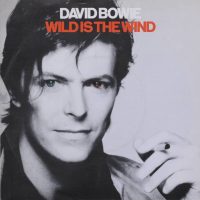 Written by: Dimitri Tiomkin, Ned Washington
Written by: Dimitri Tiomkin, Ned Washington
Recorded: 1975
Producers: David Bowie, Harry Maslin
Released: 23 January 1976
Available on:
Station To Station
Nothing Has Changed
Glastonbury 2000
BBC Radio Theatre, London June 2000
Contents
Personnel
David Bowie: vocals, guitar
Carlos Alomar, Earl Slick: guitar
George Murray: bass guitar
Dennis Davis: drums
The final song on David Bowie’s 1976 album Station To Station, ‘Wild Is The Wind’ was originally recorded for the 1957 film of the same name by singer Johnny Mathis.
Mathis’s version was nominated for an Academy Award, and reached number 22 on the Billboard chart.
‘Wild Is The Wind’ was widely covered by a range of artists, including twice by Nina Simone. She first recorded it on the 1959 live album Nina Simone At Town Hall, and again in 1966 on her studio album Wild Is The Wind.
Her performance of this song really affected me. I thought it was just tremendous, so I recorded it as an homage to Nina.
The Complete David Bowie, Nicholas Pegg
Bowie first met Simone in July 1974. She took her daughter Lisa to a Bowie concert at New York’s Madison Square Garden, on either 19 or 20 July. A few days later Simone went to the Hippopotamus nightclub at 405 East 62nd Street, and shortly afterwards Bowie arrived.
Simone decided to leave the club and walked past Bowie’s table, whereupon he invited her to join him. They spoke briefly and she gave him her phone number. Bowie called Simone at 3am the following morning.
He said, ‘The first thing I want you to know is that you’re not crazy – don’t let anybody tell you you’re crazy, because where you’re coming from, there are very few of us out there.’
What Happened, Miss Simone?, Alan Light
Bowie called her each night for a month, and they spoke for many hours. Eventually he paid her a visit, and they became firm friends.
He looked just like Charlie Chaplin, a clown suit, a big black hat. He told me that he was not a gifted singer and he knew it. He said, ‘What’s wrong with you is you were gifted – you have to play. Your genius overshadows the money, and you don’t know what to do to get your money, whereas I wasn’t a genius, but I planned, I wanted to be a rock-and-roll singer and I just got the right formula.’
What Happened, Miss Simone?, Alan Light
‘Wild Is The Wind’ strikes a rare moment of sustained serenity at the end of the cocaine neuroses of Station To Station. It is one of two pieces of quiet contemplation on the album, the other being the similarly titled ‘Word On A Wing’.
At first I thought [those songs] didn’t seem to fit, but they took the album into a more human area. They were a release moment so that he could actually cry – there was pain there, and he was able to open up on those songs.
Rolling Stone, 23 January 2017
In the studio
Bowie’s version of ‘Wild Is The Wind’ was recorded at Cherokee Studios in Los Angeles towards the end of 1975.
Seven vocal takes were recorded, although Bowie reportedly felt his first was the best, and selected it for inclusion on the album.
‘I’ve been wanting to record this song for three years,’ he said another night at Cherokee, asking to hear ‘Wild Is The Wind’ again. One of the twin ballads on the record, he was still layering it with sound and emotion. ‘This has a good European feel,’ he told me, as he finally finished the track. ‘It feels like a bridge to the future.’
June 2010
Bowie had been experimenting with his rich baritone range since 1974’s Diamond Dogs. On ‘Wild Is The Wind’ his vocals were heavy with vibrato and treated with tape echo. Although the backing took its cue from Nina Simone’s arrangement, Bowie’s vocals were all his own, adding lashings of grandeur and drama to possibly his greatest studio performance.
